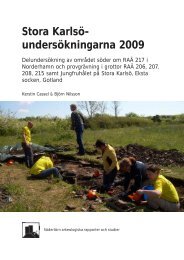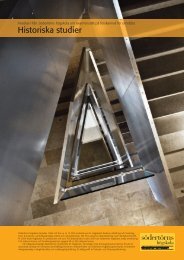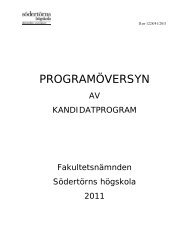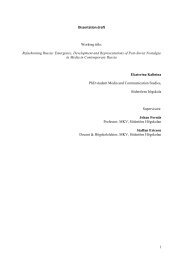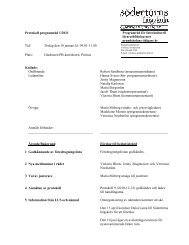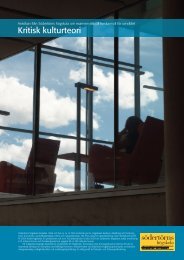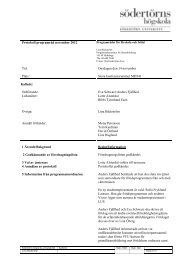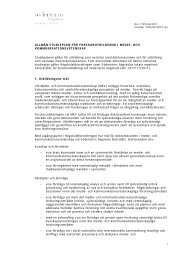CIVIL SOCIETY IN PEACEBUILDING - A Case Study Analysis of ...
CIVIL SOCIETY IN PEACEBUILDING - A Case Study Analysis of ...
CIVIL SOCIETY IN PEACEBUILDING - A Case Study Analysis of ...
Create successful ePaper yourself
Turn your PDF publications into a flip-book with our unique Google optimized e-Paper software.
AbstractThe importance <strong>of</strong> civil society for advancing peacebuilding efforts has increased and brought to a newlight after the Cold war. With the dissipations <strong>of</strong> conflict in the 1990s and the overall increasingcomplexity <strong>of</strong> peacebuilding efforts challenging the international community, the peacebuildingdiscourse started focusing on the potential role <strong>of</strong> civil society. This essay focuses on the role <strong>of</strong> civilsociety in peacebuilding in Sudan. Since the country’s declaration <strong>of</strong> independence in 1956, the Sudanas faced several internal conflicts and two civil wars. The main aim was to study civil society’s role inpeacebuilding processes and whether a “bottom-up” approach was included. There has been littlesystematic analysis <strong>of</strong> the specific role <strong>of</strong> civic engagement and civil society in the context <strong>of</strong> armedconflicts in Sudan. The aim <strong>of</strong> this study was therefore to explain the role <strong>of</strong> the civil society in Sudanand its initiatives towards peacebuilding and reconciliation between the North Sudan and the SouthSudan. A case analysis was applied across John Paul Lederach’s analytical pyramid explaining howdifferent levels <strong>of</strong> society have contributed or failed to establish peace within the society. This studydemonstrates that civil society in Sudan has had major efforts towards peacebuilding between the twomain actors, but also major roles in other reconciliation efforts.Keywords: civil society, ethnic conflict, Sudan, South Sudan, peacebuilding.2
AbbreviationsCPACSOGOsGoSGoSSICGIGAD<strong>IN</strong>GONCPNGONSCCSPFSPLASPLMSSLMUNUNDPUNICEFUSAIDComprehensive Peace AgreementCivil Society OrganizationGovernmental OrganizationsGovernment <strong>of</strong> SudanGovernment <strong>of</strong> South SudanInternational Crisis GroupIntergovernmental Authority <strong>of</strong> DevelopmentInternational Non-Governmental OrganizationNational Congress PartyNon-Governmental OrganizationsNew Sudan Council <strong>of</strong> ChurchesSudan Peace FundSudan’s People Liberation ArmySudan’s People Liberation MovementSouth Sudan Liberation MovementUnited NationsUnited Nations Development ProgrammeUnited Nations Children’s FundUnited States Agency for International Development3
1. IntroductionWith the dispassion <strong>of</strong> several conflicts after the Cold war, the peacebuilding discourse increasinglybegan to focus on the potential role <strong>of</strong> civil society. As armed conflicts are fundamental obstacles todevelopment and human rights, civil society organizations are perceived as key actors in overcomingexisting conflict lines, dissensions and organized violence. Notable failures such as Somalia andRwanda were proven that the complexity <strong>of</strong> conflict couldn’t be combated only by internationalinterventions. Civil society has therefore great roles to play, especially within democracies but evengrater roles in non-democratic countries. The question is how much space are civil society organizations(COSs) allowed to have in less developed and undemocratic countries like Sudan?In order to understand why peace has been an absent factor in Sudan, attention has to be given tothe complexity <strong>of</strong> the country’s problems. Scholars refer Sudan as a country representing a “microcosm<strong>of</strong> Africa” (Johnson 2003:25). In other words, the developments that are occurring within Sudan drawparallels from other events happening in Africa in general (Johnson 2003:37). The fragile relationshipbetween the northern and the southern regions in Sudan are only one <strong>of</strong> many issues that have beendividing the country and causing the lives <strong>of</strong> many innocent people. Violent conflicts have been an issuesince the birth <strong>of</strong> the nation in 1956 and the general paradigm on Sudan’s domestic policy has <strong>of</strong>tendealt with contradictions leading to an ethnic war. Contradictions such as “the north against the south”,Arabism versus Africanism, Muslims against Christians, “Colonization or Liberation” (Abd al-Rahim1985)(Hassan, 1985) have led to these actors drifting further apart. Such arguments have not led toreconciliation since what is beneath the visible surface is far more complex.The Sudan is unique among African countries in the sense that “it is at one and the same time both‘Arab’ and ‘African’” (Abd al-Rahim 1985:228). This ‘division’, which is partly caused by thecolonization <strong>of</strong> the country by British and Otto-Egyptian rulers, has put the north Sudan in a slightlydominant position, where its elite has desired to be Arab and Muslim while the southern part <strong>of</strong> thecountry desired to be African and de-Arabized (Sriram 2008:109).5
The protocol later culminated the Comprehensive Peace Agreement (CPA) in 2005. The CPA includedfull autonomy <strong>of</strong> the South and an interim period <strong>of</strong> sex years, with a referendum at the end <strong>of</strong> theperiod. The interim period was considered to be a chance for the North to ‘convince’ the south thatreconciliation and unity between the two parts could exist and without the north imposing discriminationand inequality (Deng 2010:8). The SPLA, however, was still fighting for a separate state for southernSudan.In January 2011 the referendum was held with a majority <strong>of</strong> registered Sudanese voters voting forseparation, which later led to south Sudan <strong>of</strong>ficially being declared independent in July 2011. Theseparation <strong>of</strong> the two states has, however, not led to an absolute peace as new conflicts have risen.8
4. Purpose and research questionsThroughout history, the importance <strong>of</strong> civil society and its characteristics has been examined anddisputed by a numerous <strong>of</strong> western philosophers and social scientists. The importance <strong>of</strong> civil society insocieties outside the Western world has, however not generated similar quantities <strong>of</strong> research (Edwards2004:10). There has been little systematic analysis <strong>of</strong> the role <strong>of</strong> civil society in the context <strong>of</strong> armedconflicts in Sudan and with this in mind, my aim with this study is therefore to examine the role <strong>of</strong> thecivil society in peacebuilding in Sudan. The specific role <strong>of</strong> civic engagement and civil society inpeacebuilding and within a fragile society is an interesting, yet difficult task. The aim is therefore toanalyze existing research knowledge on the nexus <strong>of</strong> civil society in Sudan and its peacebuilding efforts.Essentially, the hope is to depict the importance <strong>of</strong> civil society in peacebuilding between battlinggroups, and analyze the process from conflict to sustainable peace. Civil society in the context <strong>of</strong> armedconflict and its potentials, engagement, limitations and critical factors will be discussed and analyzed.Also analytical experiences and lesson learned will elucidate the complexity <strong>of</strong> the conflict and developreflections and questions for further research within the field.• Is there a connection between civil society and peacebuilding in Sudan?• What peacebuilding initiatives have been taken?• What are the challenges facing civil society organizations in Sudan?9
5. DelimitationsNo essay can study everything, and this also applies this paper. The background <strong>of</strong> the conflict is verylimited in description, including a brief description <strong>of</strong> the area’s history, which hopefully leads tounderstanding, and creation <strong>of</strong> a sufficient context for the analysis, <strong>of</strong> course. Furthermore, I would haveliked to study the link between peacebuilding, nation building and nationalism and its relation tocolonialism and local hierarchical structures but I certainly recommend others to study this because Ibelieve that this would provide further understanding <strong>of</strong> developments in region in particular andpeacebuilding in post-colonial countries in general. The main distinction has been viewed from a localor regional perspective, which then have affected the peacebuilding. It is not certain that the regionaldistinction affects the validity <strong>of</strong> the research, as it actually is a study <strong>of</strong> local and nationalpeacebuilding, not about the international involvement in peace building.The limitations <strong>of</strong> this essay will also regard the actors and the material that is being used. Theessay will primarily focus on the relationship between the north Sudan and the south Sudan, in otherwords, the majority Sudanese and the minority South Sudanese. I will not specify different tribes asSudan consists more than six hundred tribes. The choice <strong>of</strong> this delimitation is due to the fact that thesetwo groups are primary actors in the violent conflicts. Regarding the analysis <strong>of</strong> “Sudanese” civilsociety, I will include South Sudan in this description. The conflict in Darfur will be mentioned but notdeeper analyzed in the essay. This also regards conflicts in South Kord<strong>of</strong>an, Blue Nile and Bahr el-Ghazal.I have chosen to set the starting point <strong>of</strong> this account on General Nimeiry coming to power,following the years <strong>of</strong> General Omar Hassan Al-Bashir until the signing <strong>of</strong> the Machakos Protocol in2002 leading to the CPA. This choice is based on the important time period, which covers a period <strong>of</strong>high explanatory value in finding initial obstacles to reconciliation and peacebuilding within the civilsociety. The analytical frame <strong>of</strong> this essay will therefore only regard the timing before the signing <strong>of</strong> theCPA in 2005 and the independence <strong>of</strong> South Sudan in July 2011.10
6. Method and materialWhen doing a scientific research, it is important to describe the outline <strong>of</strong> the method as detailedas possible. This is crucial in order to make the study attainable for the reader (Theorell & Svensson2007:54). To carry out this study in a proper form, I would have been in Sudan and through field studiesobserved peacebuilding initiatives in Sudan. Lack <strong>of</strong> time has also limited the research method. Instead,I conducted studies <strong>of</strong> the literature and textual analysis to answer the above research questions.The study is based on a qualitative case study method, which provides an in-depth analysis <strong>of</strong>the problem and its dynamic elements. The most common definition <strong>of</strong> ‘case’ is <strong>of</strong>ten associated with astudy <strong>of</strong> a certain field or location. According to Byrman (2002), a basic structure <strong>of</strong> a case contains adetailed in-depth study <strong>of</strong> a specific case and the aim <strong>of</strong> the research is mainly to broaden the knowledgeabout a particular field <strong>of</strong> subject (Byrman 2002:42, 64). The main characteristic <strong>of</strong> a case study is theimportant unit <strong>of</strong> its definition, in other words, what is included in the case and what is intended to bestudied. A case study intends to “gather much information (data) about a specific phenomenon (thecase)(Johannessen & Tufte 2003:56), but can also include indirect phenomena in other contexts.The selection <strong>of</strong> this particular method is due to its usefulness when highlighting the complexity<strong>of</strong> an issue and its problematic aspects. The method is commonly applied in order to capture the nature<strong>of</strong> the case. <strong>Case</strong> studies also provide opportunities for comparisons between cases that can lead to afurther focus on relevant aspects that can emphasis other studies. In the end, the case studies can bringessential light to the phenomenon that is being used, while highlighting similarities and differencesthrough a clear lens (Johannessen & Tufte 2003:57). The aim <strong>of</strong> case study researches is mainly tocontribute to broaden the knowledgebase about a particular subject field (Merriam 1993:74). A largepart <strong>of</strong> the research in a case study is based on previous theories, that is to say derived facts fromexisting theories and analyzing the case further (Merriam 1993: 70).An inductive method is <strong>of</strong>ten applied to compliment case studies in order to analyze theinformation that has been gathered. The purpose <strong>of</strong> this type <strong>of</strong> method is, in most cases, not togeneralize but rather to establish an in-depth analysis <strong>of</strong> the field. The methodological strategy simplyimplies that the researcher proceeds from particular facts to general conclusion.In excess <strong>of</strong> the case study method and the inductive method, the essay is also based on a literaturestudy method. The literature study method is useful in the sense that it applies a pr<strong>of</strong>ound understanding<strong>of</strong> different strategies within the case. The method is applied in order to collect data from scientific andrelevant sources, as it allows the researcher to compare, analyze and interpret the literature. By doing so,results from several scientific studies can be sized up so that new evidence, based on knowledge, can be11
etrieved. The reason for these implementations is because it allows an extensive searching andcomparison <strong>of</strong> literature, which increases my knowledge as a researcher, about the subject.6.1 MaterialIn a literature study it is <strong>of</strong> significant importance to explain and motivate the material that isbeing used and to detail the working process since validity and reliability <strong>of</strong> the primary sources must beshown. For this reason I will do a brief presentation <strong>of</strong> the main literature sources below.The majority <strong>of</strong> the material that is used is written by researchers well oriented in the field <strong>of</strong>study and covers secondary sources including literature, articles and reports from relevant institutionsand organizations. By describing the material and its sources, personal views and opinions are left outand objectivity is maintained (Byrman 2011:43). With an inductive method applied, as mentionedearlier, the empirical study can thereby be introduced free from assumptions (Byrman 2011:43).A large part <strong>of</strong> the literature that is used in this research are scientific articles and rapports, whichare derived from the Internet via databases such as Google Scholar, Jstor, NIA- Nordic Africa Institutedatabase. These articles are scientific and reliable data since they are drawn from reliable databases andorganisations. I have however, used several books and the Internet as sources for this paper as well.6.2 Validity and ReliabilityThe aspect <strong>of</strong> research within the field <strong>of</strong> social science is to get closer to reality, or moreprecisely, get closer to everyday reality (Johannessen & Tufte 2002:22). Reality is, however complexand it is impossible to cover the overall picture <strong>of</strong> reality. It is not unfamiliar for researchers studyingthe same phenomena in the same field to come to contradictory conclusions. The validity is high whenyou really measure what you intend to measure (Bjereld, Demker, Hinnfors 2009:113). Regarding thisessays, the validity is strong because <strong>of</strong> my clear intentions <strong>of</strong> measure and what I want to measure. It istherefore an interest to demonstrate how the research is carried in order to maintain the research sotransparent as possible (Johannessen & Tufte 2002:28).The reliability is related to how a study is performed and if material was collected withouttransparency the validity will also be low. By ensuring an unbiased mindset a high transparencyincreases the reliability as well as the validity <strong>of</strong> the study. The sources <strong>of</strong> this study are clearly statedand thereby facilitating the control <strong>of</strong> material for another researcher who wish to acknowledge similarresearch.12
6.3 Critical approach to the sourcesIt is important to critically review the material that is being used. When material is not capturedthrough direct observations <strong>of</strong> participation, a critical outlook <strong>of</strong> the sources is acquired. The collection<strong>of</strong> the secondary-, or even primary data, should not be seen as a simple collection <strong>of</strong> facts, but also asinformation that has been interpreted for a cause (Alvesson & Sköldberg 2008:325). A source can bedefined as units for a researcher to use in order to receive information about a particular phenomenon. Itis therefore essential to examine what the source is and for what purpose the material was written.The lack <strong>of</strong> reliable statistic about civil engagement is the primary issue <strong>of</strong> this case. The level <strong>of</strong>reliability within CSOs can also be questioned. The absence <strong>of</strong> democratic structures in the country andwithin CSOs leads to <strong>of</strong>ficial statements and documents being unavailable. Other than the absence <strong>of</strong>governmental institutions, a few other factors contribute to the deficiency <strong>of</strong> social statistics and data;more than half <strong>of</strong> the Sudanese population live in rural areas are nomads and therefore it is complicatedto achieve information from people who are constantly on the move, and in rural and remote areas.However my intention is not to look at statistics rather it is to look at the effects and role <strong>of</strong> civilsociety in peacebuilding efforts by exploiting analytical generalizations and explicating the complex anddynamic structure <strong>of</strong> this system.The methodological approach can be questioned in the sense that the essay is only base on thestudy <strong>of</strong> literature. Looking at the empirical material, however, the volume <strong>of</strong> accumulated data and theanalytical approach <strong>of</strong> the literature at hand provides original and independent research.Further, source criticism essential in my study when I have been using secondary sources andmust take into account that my material can not be considered complete or 'objective' statements, but asinterpretations, then I as investigators should keep me critical <strong>of</strong> these to get a credible results.13
7. Concepts and Definitions <strong>of</strong> Civil SocietyFor the purpose <strong>of</strong> this study it is necessary to first clarify the role <strong>of</strong> civil society as a conceptbefore analyzing its nexus and potential for peacebuilding. The essay therefore, first considers thefundamental theoretical concepts and the different forms civil society has taken over time. It thenexplores the main roles and functions currently ascribed to civil society, taken from current research oncivil society and development cooperation. This functional scheme is then used to analyze the linkbetween civil society and peacebuilding in Sudan.The concept <strong>of</strong> ‘civil society’ itself is complex, however the term is widely used, seeming at timesto be “the big idea on everyone’s lips” (Edwards 2004:2). In order to define civil society, scholarswithin the field describes it as a position in relation to other sectors <strong>of</strong> the society. There is, however nocommonly agreed definition. The notion that civil society is the arena <strong>of</strong> voluntary collective actions,shared interests, purposes and values is non-controversial (Sriram 2008:7). The research institute,Centre for Civil Society in London considers society as its own vis-à-vis with three other main sectorsstate,business and family. Although there are some contradictions regarding this approach where someresearchers argue that family is not a separate sector and belongs to civil society (Glaius 2004:1).A slightly different approach stresses that civil society is not a sector <strong>of</strong> its own but the space betweensocietal sectors (Sriram 2008:7). Thus, actors that are attributed to specific sectors can also act in civilsociety. This understanding helps to uncover other actors who have a role in civil society, such astraditional groups in Africa (Croissant et al. 2000:18).7.1 Features <strong>of</strong> Civil Society OrganizationsThere are four rather distinguished features <strong>of</strong> civil society in general. First and foremost, civil society isconcerned with the public rather than the private. Civil society is independent <strong>of</strong> the state but isnonetheless related to it in terms <strong>of</strong> seeking benefits such as policy changes, relief or accountability(Diamond 1994:6). Importantly, civil society organizations are not only independent <strong>of</strong> the state but also<strong>of</strong> political parties. They can, however establish working relations with parties in order to achieve aparticular goal but do not affiliate themselves with political parties more than necessary (Diamond 1994:5).Pluralism, respect and tolerance are crucial definitions <strong>of</strong> civil society. Organizations that do notembrace pluralism because they believe that they have a monopoly on truth or because they believe thattheir way is the “only legitimate path” do not qualify to be apart <strong>of</strong> civil society. There has been an14
increase <strong>of</strong> ethnic, clan and faith-based organizations in Africa and among African diasporiccommunities (Chazan 1992:283). Ethnic or faith-based organizations are detrimental to civil societybecause instead <strong>of</strong> connecting, they disconnect groups and instead <strong>of</strong> bridging social relations, theyencourage and exacerbate differences by reinforcing inner-group bonding on the basis <strong>of</strong> exclusiveidentities. Their structure may not always bring positive achievements towards relationship building.Associations that do not maintain an open system <strong>of</strong> recruitment because gaining membership arebased on particular attributions <strong>of</strong> criterion such as religion, ethnicity or prohibit their members fromjoining other associations (Hadenius & Uggla 1996:162). The fourth and critical attribute is the ability t<strong>of</strong>orge alliances with other groups that have different objectives and goals (Chazan 1992:287).7.2 History <strong>of</strong> Civil Society and Philosophical RootsThe history <strong>of</strong> civil society and its conceptual debates derive from different roots and by a number<strong>of</strong> important political philosophers like John Locke (1632), Alexander de Tocqueville (1805) andAntonio Gramsci (1891). The scholars have contributed to the discourse and definitions <strong>of</strong> civil society.John Locke was first in ‘modern’ time to state that civil society is a body in its own right, separatefrom the state. He argued that people form a community which their social life develops and in whichthe state has no say. Locke referred to the sphere as pre-or-un-political and where the first task <strong>of</strong> civilsociety is to protect the individual- his/hers rights and property- against the state and its arbitraryinterventions (Sriram 2008:56).Alexander de Tocqueville stressed even more the role <strong>of</strong> the independent associations as civilsociety. He saw these associations as schools for democracy in which democratic thinking, attitudes andbehaviour are learned, also with the aim to protect and defend individual rights against potentiallyauthoritarian regimes and tyrannical majorities in society. de Tocqueville also stated that theseassociations should be built voluntarily and at all levels (local, regional, national). Antonio Gramscifocused more on civil society from a Marxist theoretical angle. According to him, civil society containsa wide range <strong>of</strong> organizations and ideologies, which both challenges and upholds the existing order. Thepolitical and cultural hegemony <strong>of</strong> the ruling classes and societal consensus is formed within civilsociety. Gramsci’s ideas influenced the resistance to totalitarian regimes in Eastern Europe and LatinAmerica (Lewis 2002:98).Two broad conclusions can be drawn from this short overview <strong>of</strong> the fundamental principles <strong>of</strong> thenotion <strong>of</strong> civil society. First, different meanings and interpretations <strong>of</strong> civil society have influencedtheoretical debate. Second, civil society has been an almost purely Western concept, historically tied to15
the political emancipation <strong>of</strong> citizens from former feudalistic ties, monarchy and the state during the 18 thand 19 th century. There is still a debate on whether these concepts <strong>of</strong> civil society are transferable totoday’s non-Western countries with different levels <strong>of</strong> democracy and economic structures (Lewis2002:67). Marginalized groups in particular need to be organized and find a way to articulate theirinterests.7.3 The Civil Society and Approaches to PeacebuildingThe importance <strong>of</strong> civil societies and its role within peacebuilding approaches and outcomesgenerated a heavy discourse after the Cold war (Edwards 2004:76) During this particular area, thenumber <strong>of</strong> armed conflicts also increased dramatically. In the aftermath <strong>of</strong> the Cold war, armed interstateconflicts decreased globally, while armed intra-state conflict increased dramatically (Edwards2004:98). During the 1990s, more than ninety percent <strong>of</strong> all existing armed conflicts were classified ascivil wars (Paris 2004:1). With the emergence <strong>of</strong> ethnic wars in Europe, Asia and Africa, the role <strong>of</strong>‘ethnicity’ became singled out as a contributing factor for armed conflict in the post Cold war era(Foreman 2003:1). The era led the international community and other actors in political science turntheir attention towards intra-state conflict resolution and management. With the fall <strong>of</strong> communism anda number <strong>of</strong> other coinciding changes, such as the emerge <strong>of</strong> new democracies, increased globalinteraction in a growingly insecure world, and a significant increase <strong>of</strong> NGOs globally, focus widelyturned towards the role <strong>of</strong> the civil society as an important factor or partner in intra-state peace buildingprocesses (Edwards 2004:2).The world anticipated that role <strong>of</strong> civil societies would be <strong>of</strong> central importance for the initiationand sustainability <strong>of</strong> peace processes. In short, numerous politicians, scholars and practitioners basicallysaw civil society and the whole concept <strong>of</strong> it as a societal sphere positioned between the individual andthe state in regard to which non-governmental and non-pr<strong>of</strong>it activities and values civility are practiced(Belloni 2001:168). As civil society widely was endorsed as a vital sphere for democratizationprocesses, the rule <strong>of</strong> law, and the respect for human rights was thereby anticipated that ethnicallydivided societies would achieve sustainable peace through civil society (Belloni 2001:63).16
7.3.1 The Civil Society and Post-conflict buildingPeacebuilding refers to the constructive steps taken to settle disagreements that prompt conflict inorder to bring lasting peace. Whether civil society organizations contribute to post-conflictpeacebuilding or exacerbate and perpetuate violence, conflicts and disagreements are dependent on thecreation and reproduction <strong>of</strong> social capital. Some civil organizations <strong>of</strong>ten undermine or deplete suchsocial resources in pursuit <strong>of</strong> particular or sectarian interests and therefore they are destroyers ratherthan builders <strong>of</strong> peace. It is for this reason, very important for civil society organizations whose activatesfoster respect, equality, trust, reciprocity, norms <strong>of</strong> cooperation and tolerance enhance constructive rolesin post-conflict peace building and in conflict-ridden societies (Edwards 2004:176). A stable peaceachievement is invariably the result <strong>of</strong> a win-win method <strong>of</strong> conflict resolution and consequently <strong>of</strong> theability to live side by side with one’s opponents in spite <strong>of</strong> difference. This is only possible in a situationwhich parties to a conflict are able and willing to empathize the plight and causes <strong>of</strong> their adversariesand when the needs <strong>of</strong> all parties in a conflict are satisfied. As long as the parties remain locked in azero-sum-game without any consideration to their needs, worries and interests <strong>of</strong> the other party, nopeace can be achieved. It is here where the critical role <strong>of</strong> civil society can play in building bridges <strong>of</strong>communication, trust, respect, and recognition in pursuit <strong>of</strong> truth, justice, peace and forgiveness withoutbeing blinded by national, ethnic, religious, partisan or sectarian interests (Chazan 1992:98). Unlessthese core values are made the centrepiece <strong>of</strong> any process <strong>of</strong> reconciliation, no durable peace is possiblein any post-conflict or conflict-ridden societies.17
8. TheoryPeacebuilding is difficult to define and even more difficult to achieve in practice (Cousens 2001:1-120). There is, however a number <strong>of</strong> researchers, important to the success <strong>of</strong> post-conflict peacebuilding, who have identified definitions <strong>of</strong> peacebuilding. The view on peacebuilding however isdiverse and may refer to many different meanings depending on the circumstances. Scholars as StephenJ. Stedman and Donald Rothchild define peace building as “strategies designed to promote a secure andstable lasting peace in which the basic human needs <strong>of</strong> the population are met and violent conflicts donot recur” (Stedman &Rothchild 2002:65). Also, as argued by Gareth Evans (1993) that “at the heart <strong>of</strong>the notion <strong>of</strong> peacebuilding is the idea <strong>of</strong> meeting needs: for security and order, for a reasonablestandard <strong>of</strong> living, and for recognition <strong>of</strong> identity and worth” (Evans 1993:39). This focus on satisfyinghuman needs derives from the conflict resolution theories <strong>of</strong> John Burton (Burton 1990:36-48). As theprocess for peacebuilding strives for new attitudes and practices, there is a need for flexible, consultativeand collaborative approaches that can operate from a contextual understanding <strong>of</strong> the root causes <strong>of</strong>conflict. This approach is based on terminating something undesired (violence) and the building <strong>of</strong>something desired trough the transformation <strong>of</strong> relationships and construction <strong>of</strong> the conditions <strong>of</strong> peace(Lederach 2000:44-55).John Paul Lederach’s theories on peacebuilding identify relationships as a central component.Lederach also argues that one <strong>of</strong> the most important needs is for peace builders to “find ways tounderstand peace as a change process based on relationship building” (Lederach 2000:35). Further, hementions that the need <strong>of</strong> peacebuilding framework towards relationship-building and similar processesis essential rather than a heavy focus on the political and legal aspects <strong>of</strong> peace agreements, truthcommissions and criminal tribunes. In the international community’s past peacebuilding practices, themain focus has turned towards the political rather than the personal which has tended to mask theunderlying psychosocial processes that mainly contribute to the willingness and readiness <strong>of</strong> people tochoose a path <strong>of</strong> peace and reconciliation rather than engaging in further mass violence and/or abuse <strong>of</strong>human rights. As argued by J. Lewis Rasmussen (2001), there is a need to set light to relationshipbuilding and reconciliation in which peacebuilding can take place (Rasmussen 2001:101-127). Althoughrelationship building is a long-term process and it has to be started as soon as possible in order forpeaceful achievements to take place.The approach to peacebuilding is versatile and the general view is that peacebuilding aims tocreate sustainable living conditions for states or specific societies after violent conflicts. Peacebuildingis used as a method for post-war regions/states in order to erase or minimize previously causes <strong>of</strong>18
conflict. In order for peacemaking and peacekeeping efforts and operations to be truly successful, it hasto include comprehensive efforts to consolidate peace, identify and support structures within the fragilesociety. This process will advance a sense <strong>of</strong> confidence and well being among people. Through talks,negotiations, agreements and most important, integration, ending civil strife can be the only chance forsurvival. Efforts may also include disarming the previously warring parties and the restoration <strong>of</strong> order,the custody and possible destruction <strong>of</strong> weapons, repatriating refugees, advisory and training support forsecurity personnel, monitoring elections, advancing efforts to protect human rights, reforming orstrengthening governmental institutions and promoting formal and informal processes <strong>of</strong> politicalparticipation. An important element in the definition <strong>of</strong> peacebuilding is the work toward reconciliation.It means that peace building should incorporate citizens for the purpose <strong>of</strong> integration that is separatedethnically or by other means.In the case <strong>of</strong> Southern Sudan, peace agreements have focused on top-levelled political andmilitary negotiations. For this reason, peacebuilding is understood within the context <strong>of</strong> top-levelledpolitics, which <strong>of</strong>ten refers to governments, large military units etcetera. Further, the peace buildingprocess should focus on rebuilding institutions and making reforms for the benefit <strong>of</strong> newadministrations, which is a crucial step towards a democratization process and has to be coherent withthe need for reforms in fragile states.Another important factor in peacebuilding is the demobilization <strong>of</strong> armed groups. Demobilizationis <strong>of</strong> great relevance when post-war societies are trying to make efforts to prevent violence. This isimportant because it may reduce the violence and threats for new-armed groups. The prevention <strong>of</strong>group mobilization and criminal activities is essential in the process <strong>of</strong> rebuilding a society.8.1 Analytical frameworkThere is an ongoing debate within peacebuilding theory where scholars are discussing the most effectiveapproach towards peacebuilding within a fragile state. John Paul Lederach, a pr<strong>of</strong>essor <strong>of</strong> InternationalPeacebuilding at the University <strong>of</strong> Notre Dame, Indiana, has constructed a “peacebuilding pyramid”which provides a method to describe different actors role within different levels <strong>of</strong> society. The levelsare: 1) the top elite, 2) the middle-range, and 3) the grassroots (Lederach 1997:38). Each level can becharacterized in terms <strong>of</strong> certain common features. Lederach argues that one must understand the role <strong>of</strong>actors, what actions are best taken at each level in order to determine how effective the approach topeacebuilding is. Since each <strong>of</strong> the three levels play a unique role in peacebuilding, different peaceprocessesmust be adopted at each level <strong>of</strong> the hierarchy. Various activities must be integrated into a19
comprehensive peacebuilding framework.The top-level elites are the primary “representatives” <strong>of</strong> their people. The elites are highly visibleand maintains an image <strong>of</strong> strength. Top-level leadership includes key principals, religious and militaryleaders, and in many cases these leaders have a great role in conflicts. Approaches to peacebuildingconcentrates on achieving peace through successful negotiation between the top-level actors in theconflict. Peacebuilding approaches at the top-level focuses on achieving cease-fire or cessation <strong>of</strong>hostilities as a first step. In such high visible environment, the negotiations face challenges inmaintaining publicly articulated goals while at the same time trying to move towards the conclusion <strong>of</strong>negotiations (Lederach 1997:44). Peacemakers such as international organizations, regional actors orcivil society organizations tend to act as mediators in order to bring the leaders to the bargaining table. Ifthe top leaders manage to agree, this will hopefully lead to the framework <strong>of</strong> imprinting peaceagreements and ending wars. Further more peace can be followed by incorporation <strong>of</strong> broader sectors <strong>of</strong>the society in peace agreements, which can later involve political leaders developing democraticinstitutions (Lederach 1997: 45).There are some problematic assumptions that Lederach mentions that underlines top-level actions.Leaders do not <strong>of</strong>ten have this sort <strong>of</strong> centralized power and also stresses that the development <strong>of</strong> peace,in most cases, does not occur in the top-level. It should also be mentioned that a more realistic approachto peacebuilding is more comprehensive when it involves the interdependence <strong>of</strong> the levels andintegrates activities <strong>of</strong> the various leaderships.The middle-level has an important role in peacebuilding according to Lederach because itconnects the top and the bottom-level. The middle-range level has therefore the greatest potential tobring people together in building peace. The middle range includes NGOs and GOs but also ethnic andreligious leaders. The middle range is also a part <strong>of</strong> a broader network that links various religious groupstogether, as well as academic institutions and humanitarian organizations (Lederach 1997:41). Theirstatus and influences <strong>of</strong>ten derives from their relationship with others as they are typically recognizedand respected within this broad network. This makes them have a remarkable capacity to influence thedecision <strong>of</strong> policymakers (Lederach 1997:41).Three central middle-range approaches to peace are: 1) problem-solving workshops, 2) conflictresolution training, and 3) peace commissions. Problem-solving workshops focus on the interactiveproblem solving and provide opportunities for actors to analyze their problems. The approach <strong>of</strong>tenallows parties in deep-rooted or violent conflicts other alternatives to generate new opinions for conflictresolution (Lederach 1997:46). They provide “a politically safe space for floating and testing ideas”(Lederach 1997:47). The third type <strong>of</strong> peacebuilding activity involves the formation <strong>of</strong> peacecommissions. Peace commissions <strong>of</strong>ten feature prominent individuals representing different sides <strong>of</strong> the20
conflict. They are established to prepare and facilitate negotiations and reconciliation efforts betweenfighting actors (Lederach 1997:50).The grassroots-level represents the population, citizens who form the base <strong>of</strong> a society. Grassrootsalso include people involved in local communities. It is an important level because <strong>of</strong> its heavy weightedmass. Because local communities <strong>of</strong>ten are split into several groups, sometimes hostile, grassrootsinitiatives <strong>of</strong>ten deal with deep-rooted hatred and animosity between fighting actors. Factors such associal and economic insecurity, political discrimination and human rights violations are primarilyexperienced at the grassroots levels. The grassroots level face challenges from those confronted by theelite and the middle-range. The bottom-up approach to peace features several approaches targeted to thegeneral population. In fact, many transitions towards peace are driven largely by pressure from thegrassroots level (Lederach 1997:52) and therefore actions taken at this level is crucial to reducingconflicts destructiveness.8.2 Bottom-up - peacebuildingPeacebuilding through a ”bottom-up” approach is about integrating the various levels and spheres<strong>of</strong> society where the goal is a unified social cooperation, which requires strong links between society’stop-, middle- and grassroots levels. Effective peacebuilding can thus not only be about a 'neutral'intervention and peace agreement at the elite level, but must also include the strengthening <strong>of</strong> localcommunities. The importance <strong>of</strong> this is in particular about changing attitudes and values among citizens,which can be difficult to achieve through diplomatic negotiations at the elite level between the parties,but perhaps easier through mediation at the grassroots level <strong>of</strong> conflict (Ramsbotham et al. 2005: 215-218). The approach also involves peacebuilding from below to link conflict resolution from a broaderperspective than the state, where international or global influences are linked to the local community.Interestingly, this perspective can identify and support peaceful local cultural resources, traditions,customs, workshops and institutions and work towards positive peace structures also in conflict to createa framework which you can work even after a conflict ends (Ramsbotham et al. 2005:218-221, 229).Certainly, this task may be easier in a relatively peaceful society than in a conflict society where suchdehumanizing propaganda and violence structures are part <strong>of</strong> everyday life, but it is not necessarilyimpossible.Peacebuilding in civil society unfortunately includes parts <strong>of</strong> civil society that stands forunpeaceful values and activities where there is a risk that the conflict spreads to hierarchical andmilitaristic structures <strong>of</strong> civil society (Ramsbotham et al. 2005: 229).21
9. Empirical resultSince Sudan gained its independence from colonial rulers Egypt and Great Britain in 1956, thecountry has faced two bloody civil wars. The main issues <strong>of</strong> Sudan consists a web <strong>of</strong> different conflictsrooted in its formation as a state, alongside marginalisation, inequalities in the economical sphere, poorgovernance, resources disputes and tribal issues. Basically the Sudan consists a myriad <strong>of</strong> differentinternal problems, which are complex and not easy for anyone to solve. The unsolved conflicts inDarfur, South Kord<strong>of</strong>an, and Blue Nile, have been a tough challenge to solve, alongside the conflictbetween the government in the north and the regional government in the south, which has receivedbiggest attention.9.1 Civil Society in SudanIf we take to consideration the issues <strong>of</strong> weak governance, related to the uneven development,unequal power sharing and the absence <strong>of</strong> democracy in Sudan, one can point out that there are manyfactors that contribute to the conflicts. The problems in Sudan should therefore be seen as one bigconflict rather than unconnected or separated conflicts. The conflicts, mainly between the north and thesouth parts <strong>of</strong> Sudan have been challenging CSOs, NGOs, <strong>IN</strong>GOs and international institutions work forenabling conflict transformation and peacebuilding. Conflict transformation is different from otherapproaches <strong>of</strong> peacebuilding, and is a complex and long process that needs efforts <strong>of</strong> many actors toaddress different factors deeply in the community. The role <strong>of</strong> conflict transformation can be seen as asocial change where affected people take the lead to make personal relationship, cultural, structuralchange, and also deepening democratization <strong>of</strong> peacebuilding where they apply community-basedbottom-up peacebuilding approach. With the assumption that civil society organizations can play a keyrole in peacebuilding through comprehensive and stabled local approach is a positive notion regardingSudan and its conflicts. Their work can be effective when relating civil society, peacebuilding anddemocratic approaches together in a non-democratic state.There are three factors that describe the work <strong>of</strong> CSOs and the civil society in general in Sudan.The first factor is the high diversity in Sudan as the country is one <strong>of</strong> the most diverse countries in analready diverse Africa and its diversification can be seen in the environmental, ecological, geologicalmake-up <strong>of</strong> the land, and also in religion, language and tribal aspects. The second factor is thecontradictory co-existence <strong>of</strong> less state and less democracy. This refers to the non-political-economiccontext, which leads to the emergence <strong>of</strong> the minimal state and more roles for CSOs to play in providing22
economic and social networks. A minimal state leads to bigger roles for the CSOs to play but in Sudan,this typical aspect leads the CSOs more roles to play but in a less smaller space to work in, by theabsence <strong>of</strong> legal liberties. The third and terminal factor is the dichotomy between the traditional civilsociety and modern civil society where modern civil society organizations are situated in the centre,urban areas and the traditional ones in sparse rural areas. There are also many other factors that can beadded to this but by considering these three factors when learning about CSOs in Sudan, one canunderstand how CSOs can play a role in peacebuilding. Regarding the role played by the CSOs in peacein Sudan, in consideration <strong>of</strong> CSOs position out <strong>of</strong> the state, the market, and the military alliance, andtogether with the communities, the diversity and pr<strong>of</strong>essionalism that they hold, they are agents byexcellence for peacebuilding. To apply their function in peace negotiations and agreements, CSOs inSudan initiated peace talks even before the government took initiative (Sriram 2003:283). There aremany examples <strong>of</strong> initiatives taken before the Sudanese government and one example is the role <strong>of</strong> theUniversity <strong>of</strong> Khartoum staff union, which was considered to be the first initiative talks where actorsfrom the north and the south in 1983 tried to negotiate before the second round <strong>of</strong> the civil war in Sudan(Johnson 2003:176). Other CSOs initiatives also came from different organizations like the Trade unionAssociation, Sudan First Association, Nadwat al Amid, Al Afad and Womens Peace Networks. TheseCSOs initiated peace talks but were <strong>of</strong>ten excluded from the formal agreements. They played however avery good role in awareness raising, building the culture <strong>of</strong> peace, co-existence and unification <strong>of</strong>families and refugee-mobilization.9.2 Peacebuilding initiativesPeacebuilding initiatives in Sudan have been conducted at the top-level before 1980 with theAddis Ababa Agreement, however between the 1980s and 2001, no specific peacebuilding initiativeswere conducted at the top-level. Important peacebuilding elements like communication, trust andrelationship building that were present in several negotiation processes were not so heavily weighted atthe end as negotiations <strong>of</strong>ten failed. The importance <strong>of</strong> good and non-partial negotiators was crucial forthe two actors. In the case <strong>of</strong> Sudan the biggest negotiation process that have had a significant impact onthe top level has been the IGAD (Intergovernmental Authority on Development) process which led tothe signing <strong>of</strong> the CPA. It started out as a regional initiative in 1994 then called IGADD(Intergovernmental Authority on Drought and Development), which led to Declaration <strong>of</strong> Principles(IGAD 1994). The IGAD process consisted <strong>of</strong> several peace talks in several places though the initiativestarted out in 1994 the process did not move forward until the year <strong>of</strong> 2002. Relationship building23
considers being the core for conflict transformation and peacebuilding. General Lazaro Sumbeiywo,who served as the mediator in the IGAD process, found it obvious that relationship building wassomething very important also at the top level <strong>of</strong> society (Simmons & Dixon 2006: 22-27). DrMohamed el-Mukhtar Hussein, one <strong>of</strong> the key members <strong>of</strong> the Government <strong>of</strong> Sudan's delegation in theMachakos-talks said that the relationship between John Garang and the vice-president Ali Osman al-Taha was a key factor in finalizing the CPA in 2005 (Hussein 2006:15). Therefore, relationship buildingwas a strong mechanism to peacebuilding at the top-level.The International Crisis Group (ICG) report from 2002 argued that SPLA was interested in endingthe second civil war and negotiating with GoS because <strong>of</strong> their longer-term military vulnerability whilethe will to negotiate for peace by the GoS was due to the US war on terrorism and the Sudanesegovernments fear <strong>of</strong> being attacked (ICG 2002: 15). The comprehensive element <strong>of</strong> the IGAD processwas left out when not linking the process <strong>of</strong> Darfur and the Eastern part <strong>of</strong> Sudan to it (ICG 2003: 1-2).Christopher Prendergast considered the initiatives on the middle-range level in Sudan to be verylimited referring to what had happened before 1997 (Prendergast 1997: 156- 157). Before 1997 anIGAD resource group had brought together Sudan experts to assist the IGAD process and New SudanCouncil <strong>of</strong> Churches (NSCC) made some efforts to maintain contacts and build relationships betweenactors at the middle- range level. The UNICEF, UNDP and the UN Department <strong>of</strong> Humanitarian Affairsworked with humanitarian diplomacy and problem-solving workshops which are a part <strong>of</strong> theapproaches Lederach puts on the middle-range level (Prendergast 1997: 157; Lederach 1997: 39).Initiatives at the middle range took a turn in 1999 as more initiatives were made.The Wunlit Peace and Reconciliation Conference was initiated by NSCC and it ranged over theborders <strong>of</strong> different states, included the participation <strong>of</strong> specific ethnic leaders and aimed to have abroader impact <strong>of</strong> reconciliation in the South. The conference is the best-known and well-documentedinitiative that took place during the second civil war between the north Sudan and the southern region(NSCC 2002: 31, 58). Paul Murphy called it effective peace activity, which can be applied in grassrootslevels (Murphy 2006: 65), but considers also participants like military commanders, community leaders,chiefs and intellectuals, which belong to the middle-range level in this analysis. This initiative was alsocalled people-to-people initiative that was going to spark more and more <strong>of</strong> those especially on thegrassroots level.Concordis International Organization started a programme in 1999 where they initiated processestowards peace and relationship building at the middle-range society level in Sudan. Their main focuswas to build and strengthen relationships between key players at this level in order for them to discussissues in a non-threatening environment and also to get them in contact with the broader society. Butunfortunately the relationship between these initiatives was not as successful as the IGAD-approach.24
The lack <strong>of</strong> contact in between the different initiatives on the different levels was something thatcharacterized the process in Sudan before the CPA. The two leading parties, the SPLM/A and the GoS,excluded other parties during the whole process (Simmons & Dixon 2006: 62). The initiatives supportedclosely by GoS or SPLM might not belong to the middle-range level considering Lederach’sexplanations about the leadership on this level. Dialogues and small negotiations that led to some goodoutcomes like written agreement <strong>of</strong> tribal leaders to work on peacebuilding and restoring relationshipsand specific local agreements. (Bradbury; Ryle; Medley; Sansculotte-Greenidge 2006: 161-165). In thecase <strong>of</strong> Sudan before the CPA the middle-range level does not seem to have had a lot <strong>of</strong> attention.Concerning the timeline <strong>of</strong> peace building in the case <strong>of</strong> Sudan the process on the grassroots levelstarted before the process on the top-level. According to Rift Valley institute’s base line study from2006 have many peacebuilding and conflict transformation activities have been supported throughgrassroots-initiatives in Sudan. They argue that the interest <strong>of</strong> support the local level was big (Bradbury,Ryle, Medley, Sansculotte-Greenidge 2006: 6). As many <strong>IN</strong>GOs work with the civil-society, it ishowever hard to define who is a representative <strong>of</strong> the civil-society or not. There are cases when thetraditional leaders are approached as being a part <strong>of</strong> the civil society and then the next day they appearto be warlords (Bradbury; Ryle; Medley; Sansculotte-Greenidge 2006: 14).To separate what has been conducted at the middle-range level and at the grassroots level is not aneasy task in the myriad <strong>of</strong> peace-building efforts. The study from the Rift-Walley institute that hasmapped local peace processes includes mostly the grassroots level but also the middle-range levelthrough the participation <strong>of</strong> specific ethnic and religious leaders and intellectuals (Lederach 1997: 41).Sudan being the biggest country in Africa and with a lot <strong>of</strong> different leaders at different levels makes ithard to distinguish them from each other. Most <strong>of</strong> the initiatives at the grassroots level were conductedin Southern Sudan between the different ethnic groups. The only reconciliation initiatives conductedbefore the CPA was signed that included communities on the government side and communities on theSPLA areas (Bradbury, Ryle, Medley, Sansculotte- Greenidge 2006: 21).The GoS, SPLM and UNICEF were also big initiators to the cross- border issues and interfaithdialogues. (Bradbury; Ryle; Medley; Sansculotte-Greenidge 2006: 171-173). Between 1983 and January2005 accomplished dialogues within the grassroots level, CSOs managed to discuss issues like cessation<strong>of</strong> hostilities, return <strong>of</strong> abducted children, forgiveness, reconciliation in between local communities andso forth (Bradbury; Ryle; Medley; Sansculotte-Greenidge 2006: 147-150). From the initiatives held,nine <strong>of</strong> them were held 2002 and later, which is only 3 years before the CPA was signed. In the southernregion, however the documented initiatives counts up to thirty-eight meetings but with a start in 1994.The signing <strong>of</strong> the CPA could therefore be seen as result <strong>of</strong> a long an active peacebuilding process fromCSOs. The initiatives taken from CSOs covered for example sharing <strong>of</strong> natural resources, women25
dialogues but also a covenant <strong>of</strong> Peace and Reconciliation in Liir 2000 (Bradbury; Ryle; Medley;Sansculotte-Greenidge 2006: 150-157).NSCC continued with more initiatives on the grassroots level in the Upper Nile area <strong>of</strong> southernSudan in 1999. The peacebuilding initiatives conducted by the NSCC on the middle range andgrassroots levels, people-to-people peace making, were inclusive dialogue meetings to deal withdifferent issues. Something <strong>of</strong> specific interest was that in the people-to-people initiatives in SouthernSudan women played a leading key role (Itto 2006: 57). From the year <strong>of</strong> 2002 and three years ahead aSudan Peace Fund (SPF) was created by the USAID the SPF started to support the people-to-peopleprocess and they were able to spread the initiatives (Murphy 2006: 66). The people-to-people dialoguesin the south preceded the negotiation talks between the north and the south.Between the year <strong>of</strong> 2002 and 2005 eight local peace talks were held in Bahr el Ghazal, anotherstate in the South, mainly by NSCC and the SPF but also UNICEF, PACT Sudan (coalition <strong>of</strong> <strong>IN</strong>GOsand NGOs) and OXFAM were supporters. The outcomes were a series <strong>of</strong> community peace agreements,initiations <strong>of</strong> peace councils at the local level, reconciliation and restoration <strong>of</strong> free movement and s<strong>of</strong>orth (Bradbury; Ryle; Medley; Sansculotte- Greenidge 2006: 160-161). Some other grassrootsinitiatives in Bahr el Ghazal were the “peace-markets” which formed free passage for trade between theethnic groups. They are considered to have prepared the ground for normalisation <strong>of</strong> relations as muchas sponsored peace-talks (Bradbury; Ryle; Medley; Sansculotte-Greenidge 2006: 74-75).In southern Sudan, there were some general local processes that included both actors from themiddle-range level and the grassroots level. NSCC and SPLM were also here the big supporters but alsoSPF, PACT, Norwegian Church Aid and DanChurchAid. For example these included dialogues betweenpolitical and social leaders, women’s representatives, civil and military authorities, intellectuals and s<strong>of</strong>orth (Bradbury; Ryle; Medley; Sansculotte-Greenidge 2006: 174-175). Considering the local conflictsin the eastern region <strong>of</strong> Sudan, there have been very little attempts to work with peacebuilding andreconciliation efforts at the grassroots level. In southern Sudan, specifically when in comes to thepeople-to-people initiatives, many <strong>of</strong> the cases were to see a broader impact. Not only to buildrelationships in between some groups but to work with reconciliation in the entire Sudan (Bradbury;Ryle; Medley; Sansculotte-Greenidge 2006: 165-171).It is hard to measure if the initiatives on the grassroots level had any impact on the CPA, theIGAD process and the contemporary situation in Sudan. Concerning the timeframe most <strong>of</strong> them seemto have been conducted during the last five year before the CPA. Local peacebuilding cannot be asubstitute for a national peace agreement (Bradbury; Ryle; Medley; Sansculotte-Greenidge 2006: 9), butI would argue that a peace agreement could not succeed without the support <strong>of</strong> the masses and besustainable in a society with a protracted conflict. Local processes are limited in how they can affect26
structural changes in the society because <strong>of</strong> being far from the decision tables but they can still have animpact on the processes. The actors on the top-level <strong>of</strong> society are also somehow members <strong>of</strong> thegrassroots level, they all come from somewhere being connected with the masses. But what can makethe connection better is probably what Lederach suggests, the middle-range actors capturing the moralimagination.9.3 Problems facing Civil Society Organizations in SudanThere are internal problems as well as external problems regarding CSOs work towardspeacebuilding in Sudan. The internal problems are <strong>of</strong>ten dealt with the fact that most powerful CSOs areurban based in Khartoum or in other big cities which contributes to the weak membership-basedgeographical, ethnic and religious representation, which leads to a lack <strong>of</strong> ‘internal democracy’. CSOs inSudan in general lack long-term strategic vision. They also have weak self-finances, dependent onforeign funding and vulnerable to external influences. The formal structure <strong>of</strong> these organizations aremixed with informal structure <strong>of</strong> ethnicity and politics so in many CSOs in urban or in rural areas thereare dimensions <strong>of</strong> politics, here and there. It makes it easy to find political dimensions or agendas insidethe CSOs in urban and rural mixed with ethnic dimensions.As mentioned earlier, most <strong>of</strong> the important CSOs are in the rural areas were they are weak, withminimal resources comparable with the urban based CSOs. The rural CSOs are important as the ruralareas lack “urban knowledge”. Ethnic and religious influences are strong in rural areas and therefore aregreat tools to use when extreme groups want to continue the fighting. Conflict transformation istherefore important in rural areas.One important external dimension is the role <strong>of</strong> <strong>IN</strong>GOs and other donors. The main focusregarding external issues is <strong>of</strong>ten due to <strong>IN</strong>GOs minimal attention to the high diversity <strong>of</strong> localcommunities and CSOs. This creates many counter effects, as <strong>IN</strong>GOs and donors seem to lack a deepunderstanding <strong>of</strong> CSOs capacities in the specific context <strong>of</strong> Sudan where the objective and expectation<strong>of</strong> <strong>IN</strong>GOs and donors regarding civil society organizations in Sudan are too high. The partnershipbetween these organizations is not a genuine partnership but only a kind <strong>of</strong> disparity and a lead todependence given the low capacity for CSOs achieving self-finance and self-empowerment is difficult.Also without mutual, bilateral, transparency, accountability and risk sharing, the relation between CSOsand <strong>IN</strong>GOs shows a high <strong>of</strong> imbalance <strong>of</strong> power. <strong>IN</strong>GOs and donors tend to support urban-based CSOsrather than rural-based CSOs more. The donors <strong>of</strong>ten trust urban-based organization because they can27
mark themselves better than the CSOs in rural areas. Regarding peacebuilding, however, there is a needfor the rural areas to be incorporated in <strong>IN</strong>GOs work and not only urban CSOs.If we return to the structural problems <strong>of</strong> the Sudan, the first component is related to the lowsecurity, complete or partial law-less suppression <strong>of</strong> human rights and the structure <strong>of</strong> physicalinfrastructure, which can be related to the civil war itself. The second structure is the lack <strong>of</strong> democracyas in necessary enabling conditions for CSOs to operate, including to work to grant liberties anddemocratic rights for the people. This is not only a key aspect for the work <strong>of</strong> these organizations butalso one <strong>of</strong> the solutions for the conflicts in Sudan, as I said before, the continuation <strong>of</strong> these differentconflicts in Sudan is due to taking the approach <strong>of</strong> partial solutions and not that holistic andcomprehensive solution that address the issue <strong>of</strong> an equal development and equal power-sharing.The CSOs in Sudan have had and still has important roles to play in peacebuilding. The Sudanesepeople have shown courage and have also raised its capacities for self-improvement but there is still aneed <strong>of</strong> great improvements. The CSOs work towards peacebuilding is due to great space and dialogue,constructive engagement with government <strong>of</strong>ficials and for donors to provide with possibilities with theinternational community and <strong>IN</strong>GOs having much deeper understand <strong>of</strong> the particular context <strong>of</strong> Sudan.It is critical to mention that peace is important, not only within the north or south regions <strong>of</strong> Sudanbut also between the two and a shared vision for peace should be promoted. One major aspect isdemocratization <strong>of</strong> CSOs where the link between democratic CSOs and peacebuilding is well known asstrong which that this can play a great role in achieving peace. And by consulting communities toenhance democratic policies, democracy within CSOs and hopefully in the country, can be establishedin the future.28
10. ConclusionThis concluding chapter presents general conclusions from the research and discusses further researchthat can be addressed in in-depth case study researches. A good understanding <strong>of</strong> civil society’s role isrequired when civil society aims to have an impact on peacebuilding. This is equally important fornational or local societies and their strategies as well as for outside supporters. However, this essayconcludes that the civil society and its function in peacebuilding discourse and development lead to agreater understanding <strong>of</strong> the role <strong>of</strong> civil society in peacebuilding within states.This study also demonstrates that it is necessary to analyze the enabling conditions for civil society t<strong>of</strong>ulfil a constructive role in peacebuilding. Not only is it necessary to identify the relevant functions <strong>of</strong>civil society within peacebuilding, but also the composition <strong>of</strong> civil society, especially in nondemocraticcountries like Sudan. Traditional groups, social movements and mass organizations are veryimportant civil society actors in peacebuilding that need to be considered more systematically. Civilsociety has therefore important roles to play in peacebuilding, if they have the right functions.Democracy and peacebuilding research shows that civil society has played a crucial role indemocratic transitions in Eastern Europe after the Cold war. This study demonstrates that civil societycan make important contributions to peacebuilding in the short, medium and long run. The most strikingresult in civil society peacebuilding research shows a direct correlation between civil societyinvolvement in peace negotiations and the sustainability <strong>of</strong> agreements- the greater the involvement <strong>of</strong>civil society the more likely the peace agreements will be sustained. The most important civil societyfunction in peacebuilding seems to be advocacy, particularly in terms <strong>of</strong> making the voices <strong>of</strong> civilsociety heard and bridging important issues to the peacebuilding agenda. Other civil society roles arealso important <strong>of</strong> civil society, and through joint activities that can build bridging ties across dividedsocieties.Not all civil society functions are equally effective in all phases <strong>of</strong> conflict. It is also important torecognize that depending on the functions <strong>of</strong> civil society, these will have different priorities dependingon the phases <strong>of</strong> conflict. During armed conflict or in the immediate aftermath the functions <strong>of</strong>protection, monitoring and public communication seem to have clearly priority. Civil society needs afunctioning state to operate effectively and therefore the role <strong>of</strong> the state is equally important. Due toweakness <strong>of</strong> the state and unclear power relations and networks, civil society is affected by a strongauthoritarian state that suppresses civil society. In the case <strong>of</strong> a weak state, civil society support mayneed to focus on the enabling environment, including support to state structures and law enforcement aswell as specific support to civil society functions.29
Civil society in general is however not always good and has a dark side. Many civil societiesactors in Sudan show uncivil behaviours, preach hatred against other groups, and can incite violence.This seems to be especially likely during and in the immediate aftermath <strong>of</strong> armed conflict, when theweakness <strong>of</strong> the state <strong>of</strong>fers greater opportunities for uncivil groups to thrive.30
Reference listAlvesson, Mats, Kaj Sköldberg (red.)(2008) Tolkning och reflektion:vetenskapsfilos<strong>of</strong>i och kvalitativmetod. Lund:Studentlitteratur.Al-Rahim, Muddathir (1986) Sudan Since Independence: Studies <strong>of</strong> Political Development since 1956.Aldershot: Gover.Bergström, Göran och Kristina Boréus (red.) (2005) Textens mening och makt. Metodbok isamhällsvetenskaplig text och diskursanalys. Lund: Studentlitteratur.Bjereld, Ulf, Marie Demker, Jonas Hinnfors (red.)(2009)Varför Vetenskap?- om vikten av problem ochteori i forskningsprocessen. Lund:Sudentlitteratur.Boréus, Kristina och Göran Bergström (red.) (2005) Textens mening och makt. Metodbok isamhällsvetenskaplig text och diskursanalys. Lund: Studentlitteratur.Bradbury, Mark, Ryle, John, Medley, Michael, Sansculotte-Greenidge, Kwesi (ed.)(2006) Local PeaceProcesses in Sudan: A Baseline <strong>Study</strong>. Rift-Walley Institute. Downloaded 6 April2011(http://www.sudanarchive.net).Byrman, Alan (2008) Social Reseach Method.Third Edition. Oxford: University Press.Chazan, Naomi (1992) Politics and Society in Contemporary Africa. Second Edition. BoulderColorado: Rienner, Basingstoke, MacMillan.CPA, (2005) “The Comprehensive Peace Agreement between The Governemnt <strong>of</strong> the Republic <strong>of</strong> TheSudan and The Sudan People’s Liberation Movement/Sudan People’s Liberation Army”, Nairobi Kenya9th January, 2005.Printed by: UNMIS, Public Information Office.Deng, Francis (2004) Sudan’s Civil War: The peace proces before and since the Machakos. Pretoria:South Africa.Diamond, Louise, Joh McDonald (1996) Multi-Track Diplomacy: A Systems Approach to Peace. WestHartford, CT: Kumarian Press.Edwards, Michael (2004) Civil Society. Cambridge: Polity Press.Esaiasson, Peter, Mikael Gilljam, Henrik Oscarsson, Lena Wängnerud (red.) (2004) Metodpraktikan.Konsten att studera samhälle, marknad och individ. Stockholm:Elanders Gotab.Evans, Gareth (1993) Cooperating for Peace: the global agenda for the 1990s and beyond.St.Leonards, NWS: Allen and Unwin.Glasius, Marlies (2004) Global Civil Society. London:SAGE31
Hadenius, Axel, Fredrik Uggla (1995) Making Civil Society Work:Promoting DemocraticDevelopment: What can states and donors do? Uppsala University.Hussein, el-Mukhtar Mohamed (ed.) (2006) “Negotiating Peace, the Road to Naivasha” in Simmons,Mark and Peter Dixons Accord, Peace by Piece, Addressing Sudan’s Conflicts. London: ConciliationResources.ICG, (2002) “Capturing the Moment: Sudan’s Peace Process in the Balance”, International Crisis GroupAfrica Report no. 42, 3 April 2002. Downloaded 29 May 2011.(www.crisisgroup.org/library/documents/report_archive/A400604_03042002. pdf )ICG, (2003) “Sudan: Towards an Incomplete Peace”, International Crisis Group Africa Report no. 73,11th December 2003. Downloaded 29th May 2011.(www.crisisgroup.org/library/documents/africa/horn_<strong>of</strong>_africa/076_darfur_sudan_new_crisis)IGAD (1994) Declaration <strong>of</strong> Principles (www.sossa.de/igad.html)Itto, Anne (ed.) (2006) “Guests at the Table? The role <strong>of</strong> women in peace processes” in Simmons, Markand Peter Dixon Accord, Peace by Piece, Addressing Sudan’s Conflicts. London: ConciliationResources.Johannessen, Asbjorn, Per Arne Tufte (2003) Introduktion till samhällsvetenskaplig metod. Malmö:Liber AB.Johnson, Douglas H (2003) African Issues. The Root Causes <strong>of</strong> Sudan’s Civil Wars. Indiana :UniversityPress.Joireman, Sandra (2003) Nationalism and Political Identity. London: Continuum.Kurunmäki, Jussi (red.)( 2005) “Begreppshistorik” i Bergström, Göran, Kristina BoréusTextens mening och makt. Metodbok i samhällsvetenskaplig text och diskursanalys.Lund: Studentlitteratur.Lederach, John Paul, (1997) Building Peace, Sustainable Reconciliation in Divided Societies.Washington: United States Institute <strong>of</strong> Peace.Lederach, John Paul, 2005. The Moral Imagination, The Art and Soul <strong>of</strong> Building Peace. New York:Oxford University Press.Lewis, David (2002) Civil Society in African Contexts. Reflections on the Usefulness <strong>of</strong> a Concept.London:Routledge.Merriam, Sharan B. (1993) Fallstudien som forskningsmetod. Lund: Studentlitteratur.Murphy, Paul, (2006) “The Delicate Practice <strong>of</strong> Supporting Grassroots Peacebuilding in SouthernSudan” in Simmons, Mark, Peter Dixon (ed.) Accord, Peace by Piece, Addressing Sudan’s Conflicts.London: Conciliation Resources.Paris, Roland (1997) Peacebuilding and the Limits <strong>of</strong> Liberal Internationalism. London:Routhledge.32
NSCC (2002) Inside Sudan, The Story <strong>of</strong> People to People peacemaking in Southern Sudan. New SudanCouncil <strong>of</strong> Churches, October 2002. Nairobi: NSCC.Prendergast, John (1997) “Applying Concepts to <strong>Case</strong>s: Four African <strong>Case</strong> Studies” in Lederach, JohnPaul, Building Peace, Sustainable Reconciliation in Divided Societies. Washington: United StatesInstitute <strong>of</strong> Peace.Ramsbotham, Oliver, Tom Woodhouse, Huge Miall (ed.)(2005) Contemporary Conflict Resolution,Cambridge, Malden: Polity Press.Rasmussen, J. Lewis, (2001) “Negotiating a Revolution, Toward, Integrating Relationship Building andReconciliation into Official Peace Negotiations” in Abu-Nimer, Mohammed (ed.) Reconciliation,Justice, and Coexistence. Lanham: Lexington Books.Simmons, Mark, Peter Dixon (2006) The Role <strong>of</strong> Track Two Initiatives in Sudanese Peace Processes.London: Conciliation Resources.Stedman, John, Donald Rothchild, Elizabeth Cousens (2002) Ending Civil Wars: The implementation <strong>of</strong>Peace agreements. Boulder, Colorado:Lynne Rienner.Sriram, Leika Chandra (2008) Power- Sharing, Armed Groups and Contemporary Peace Negotiations.Hampshire: Palgrave MacMillan.Teorell, Jan, Torsten Svensson (2007) Att fråga och att svara: samhällsvetenskaplig metod.Malmö: Liber AB.Thomas, Edward (2009) “Against the Gathering Storm, Securing Sudan’s Comprehensive PeaceAgreement”. London: The Royal Institute <strong>of</strong> International Affairs. Downloaded on March 2011.(www.chathamhouse.org.uk/publications/papers/view/-/id/688/).33



